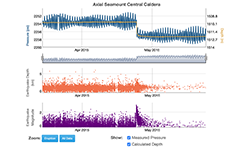Magma Movement and the Shape of the Seafloor - Instructor's Guide
Published ???
Summary

Students can explore how primary production, temperature, salinity, and dissolved oxygen varies in an area that experiences upwelling (North Pacific - Coastal Endurance Array) and an area that does not (South Pacific - Coastal Pioneer Array) for a time period extending May 2016-Oct 2017.
Students will be able to explore patterns in how the chlorophyll-a concentration, temperature, salinity, and/or oxygen data varies over time in the Northern Pacific Ocean.
They will apply this knowledge by comparing patterns in chlorophyll-a concentration, salinity, and oxygen data between the Northern Pacific Ocean (Coastal Endurance Array) and the Northern Atlantic Ocean (Coastal Pioneer Array). Using what they learned from the North Pacific Ocean they will make a prediction for temperature in the Northern Atlantic Ocean by drawing your own lines on the graph.
Learning Goals
After engaging with this Data Exploration a student will be able to:
Context for Use
TBD
Teaching Notes
TBD
Invitation: As an introductory activity, you can:
Concept Invention:
Application:
Reflection:
Subject / Topics
Introduction to Oceanography
Grade Level (2 options)
Data Scope
Our scope in exploring ways to use professionally-collected data in our teaching:
Quantitative Skills
Most of the quantitative reasoning in this exercise revolves around reading and interpreting graphs.
Science Explanation
TBD